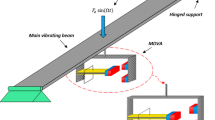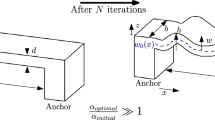Abstract
This study presents an experimental method for identification of the backbone curves of cantilevers using the nonlinear dynamics of a van der Pol oscillator. The backbone curve characterizes the nonlinear stiffness and nonlinear inertia of the resonator, so it is important to identify this curve experimentally to realize high-sensitivity and high-accuracy sensing resonators. Unlike the conventional method based on the frequency response under external excitation, the proposed method based on self-excited oscillation enables direct backbone curve identification, because the effect of the viscous environment is eliminated under the linear velocity feedback condition. In this research, the method proposed for discrete systems is extended to give an identification method for continuum systems such as cantilever beams. The actuation is given with respect to both the linear and nonlinear feedbacks so that the system behaves as a van der Pol oscillator with a stable steady-state amplitude. By varying the nonlinear feedback gain, we can produce the self-excited oscillation experimentally with various steady-state amplitudes. Then, using the relationship between these steady-state amplitudes and the corresponding experimentally measured response frequencies, we can detect the backbone curve while varying the nonlinear feedback gain. The efficiency of the proposed method is determined by identifying the backbone curves of a macrocantilever with a tip mass and a macrocantilever subjected to atomic forces, which are representative sources of hardening and softening cubic nonlinearities, respectively.








Similar content being viewed by others
References
Gupta, A., Akin, D., Bashir, R.: Single virus particle mass detection using microresonators with nanoscale thickness. Appl. Phys. Lett. 84, 1976 (2004)
Ono, T., Li, X., Miyashita, H.: Mass sensing of adsorbed molecules in sub-picogram sample with ultrathin silicon resonator. Rev. Sci. Instrum. 74, 1240 (2003)
Binnig, G., Quate, C.F., Gerber, C.: Atomic force microscope. Phys. Rev. Lett. 56, 930 (1986)
Okajima, T., Sekiguchi, H., Arakawa, H., Ikai, A.: Self-oscillation technique for AFM in liquids. Appl. Surf. Sci. 210, 68 (2003)
Wang, G., Tan, C., Li, F.: A contact resonance viscometer based on the electromechanical impedance of a piezoelectric cantilever. Sens. Actuator A Phys. 267, 401–408 (2017)
Villanueva, L.G., Karabalin, R.B., Matheny, M.H., Chi, D., Sader, J.E., Roukes, M.L.: Nonlinearity in nanomechanical cantilevers. Phys. Rev. B 87, 024304 (2013)
Vakakis, A.: Non-linear normal modes (NNMS) and their applications in vibration theory: an overview. Mech. Syst. Signal Process. 11, 3–22 (1997)
Kerschen, G., Peeters, M., Golinval, J.C., Vakakis, A.: Nonlinear normal modes, Part I: a useful framework for the structural dynamicist. Mech. Syst. Signal Process. 23, 170–194 (2009)
Grenat, C.: Nonlinear normal modes and multi-parametric continuation of bifurcations: Application to vibration absorbers and architectured MEMS sensors for mass detection. Dynamique vibrations, Universite de Lyon, English. NNT: 2018LYSEI078 (2018)
Kuether, R.J., Renson, L., Detroux, T., Grappasonni, C., Kerschen, G., Allen, M.S.: Nonlinear normal modes, modal interactions and isolated resonance curves. J. Sound Vib. 351, 299–310 (2015)
Kumar, V., Boley, J., Yang, Y., Ekowaluyo, H., Miller, J., Chiu, G., Rhoads, J.: Modeling, analysis, and experimental validation of a bifurcation-based microsensor. J. Microelectromech. Syst. 21, 549–558 (2012)
Tadokoro, Y., Tanaka, H., Dykman, M.: Driven nonlinear nanomechanical resonators as digital signal detectors. Sci. Rep. 8, 11284 (2018)
Wolf, K., Gottlieb, O.: Nonlinear dynamics of a noncontacting atomic force microscope cantilever actuated by a piezoelectric layer. J. Appl. Phys. 91, 4701–4709 (2002)
Maraldo, D., Mutharasan, R.: Mass-change sensitivity of high-order mode of piezoelectric-excited millimeter-sized cantilever (PEMC) sensors: theory and experiments. Sens. Actuators B 143, 731–739 (2010)
Bashir, R., Butt, H., Grattarola, M.: Micromechanical cantilever as an ultrananosensitive pH microsensor. J. Appl. Phys. 81, 3091–3093 (2002)
Cueva-Perez, I., Osornio-Rios, R.A., Stiharu, I., Perez-Cruz, A.: Extraction of nonlinear elastic parameters of paper from the amplitude-dependent frequency response of cantilever beams. Int. J. Non-Linear Mech. 111, 42–48 (2019)
Feldman, M.: Non-linear system vibration analysis using Hilbert transform—I. Free vibration analysis method ’Freevib’. Mech. Syst. Signal Process 8, 119–127 (1994)
Feldman, M.: Non-linear free vibration identification via the Hilbert transform. J. Sound Vib. 208, 475–489 (1997)
Feldman, M.: Identification of weakly nonlinearities in multiple coupled oscillators. J. Sound Vib. 303, 357–370 (2007)
Wei, Y., Dong, Y., Huang, X., Zhang, Z.: A stepped frequency sweeping method for nonlinearity measurement of microresonators. Sensors 16, 1700 (2016)
Ta, M., Lardies, J.: Identification of weak nonlinearities on damping and stiffness by the continuous wavelet transform. J. Sound Vib. 293, 16–37 (2006)
Londono, J., Neild, S., Cooper, J.: Identification of backbone curves of nonlinear systems from resonance decay responses. J. Sound Vib. 348, 224–238 (2014)
Renson, L., Gonzalez-Buelga, A., Barton, D.A.W., Neild, S.A.: Robust identification of backbone curves using control-based continuation. J. Sound Vib. 367, 155–158 (2016)
Mojrzisch, S., Twiefel, J.: Phase-controlled frequency response measurement of a piezoelectric ring at high vibration amplitude. Arch. Appl. Mech. 86, 1763–1769 (2016)
Denis, V., Jossic, M., Giraud-Audine, C., Chomette, B., Renault, A., Thomas, O.: Identification of nonlinear modes using phase-locked-loop experimental continuation and normal form. Mech. Syst. Signal Process. 106, 430–452 (2017)
Peter, S., Leine, R.: Excitation power quantities in phase resonance testing of nonlinear systems with phase-locked-loop excitation. Mech. Syst. Signal Process. 96, 139–158 (2017)
Kokubun, Y., Yabuno, H.: Stiffness sensor for cubic nonlinear elasticity using nonlinear self-excited oscillation. J. Vib. Acoust. 136, 031011 (2014)
Nayfeh, A.H., Mook, D.T., Lobitz, D.W.: Numerical-perturbation method for the nonlinear analysis of structural vibrations. AIAA J. 12, 1222–1228 (1974)
Ray, J.D., Wesley, B.C.: Nonlinear vibrations of a beam with pinned ends. J. Eng. Ind. 91, 997–1004 (1969)
Crespo da Silva, M.R.M., Glynn, C.C.: Nonlinear flexural-flexural-torsional dynamics of inextensional beams. I. Equations of motion. J. Struct. Mech. 6, 437–448 (1978)
Lacarbonara, W., Yabuno, H.: Refined models of elastic beams undergoing large in-plane motions: theory and experiment. Int. J. Solids Struct. 43, 5066–5084 (2006)
Anderson, T.J., Nayfeh, A.H., Balachandran, B.: Experimental verification of the importance of the nonlinear curvature in the response of a cantilever beam. J. Vib. Acoust. 118, 21–27 (1996)
Thompson, J.M.T., Stewart, H.B.: Nonlinear Dynamics and Chaos. Wiley, New York (2002)
Ekinci, K.L., Roukes, M.L.: Nanoelectromechanical systems. Rev. Sci. Instrum. 76, 061101 (2005)
Meirovitch, L.: Elements of Vibration Analysis, International Student Ed., McGraw Hill (1975)
Acknowledgements
This study was supported in part by a Grant-in-Aid for Scientific Research B (Grant No. 19H0209B) from the Japan Society for the Promotion of Science (JSPS).
Author information
Authors and Affiliations
Corresponding author
Ethics declarations
Conflict of interest
The authors declare that they have no conflict of interest.
Additional information
Publisher's Note
Springer Nature remains neutral with regard to jurisdictional claims in published maps and institutional affiliations.
Appendices
Nondimensionless equation of motion
The nondimensionless equation of motion is derived as:
The associated boundary conditions are:
In Eq. (45), the equivalent damping effect, i.e., \(c\frac{\partial v}{\partial t}\), is introduced.
Change of self-excited mode depending on the cut-off frequency of the filter
In sec. 4.1, we use the low-pass filter in order to cut the noise and the self-excited oscillations higher than the second mode. Unlike the single-degree-of-freedom system in our previous study [27], continuum systems such as a cantilever in the present study can be self-excited with any natural frequencies under the velocity feedback. In fact, as mentioned below, it is experimentally shown that the self-excited oscillation is produced with the second mode depending on the cut-off frequency of the filter. The experimental system when a relatively long cantilever beam made from phosphor bronze was used is shown in Fig. 9a; the dimensions are 0.216 \(\times \) 0.02 \(\times \) 0.002 m. The position of the laser displacement sensor is the same as Fig. 4. Figure 9b shows the frequency spectrum when the self-excited oscillation is produced by our feedback control. The red line shows that the cantilever is self-excited with the first natural frequency when the cut-off frequency is 6 Hz below the first natural frequency. On the other hand, when the cut-off frequency is set to be 18 Hz above the second natural frequency, the cantilever is not self-excited with the first mode but the second one.
Change of self-excited mode depending on the cut-off frequency of the filter. a Cantilever whose natural frequency is set to be low in order to observe the higher mode oscillation. b Response frequency when the cut-off frequency is 6 Hz. The self-excited oscillation is produced with the first natural frequency. c The response frequency when the cut-off frequency is 18 Hz. The self-excited oscillation is produced with the second natural frequency
Construction of the verification system. A disk is attached at the tip of the cantilever, which is same as that shown in Fig. 4, and means that the cantilever is subjected to relatively high viscous damping from the water. The mass and radius of this disk are 20 \(\times 10^{-3}\) kg and 25 \(\times 10^{-3}\) m, respectively
Identification in a viscous damping environment
In this appendix, we show that the proposed method can identify the backbone curve independently of the magnitude of viscous damping in the environment through comparison of the backbone curve obtained for a specimen that was subject to fluid viscosity with the corresponding curve obtained for the same specimen in air.
Figure 10 shows the additional system required to validate the effect of the viscosity on the results. A thin disk is attached at the tip to increase the damping of the cantilever. We performed the experiment under two conditions: the first was the low damping condition, i.e., where the disk was set in air, and the second was the relatively high damping condition, i.e., where the disk was immersed in water. The comparison of the free decay responses is shown in Fig. 11, where the blue and red lines show the responses under the low and high damping conditions, respectively. The decay characteristics are different, because the water provides a larger dissipative force.
Next, we show the backbone curve obtained using the proposed method in Fig. 12, where the blue and red markers represent the experimental results obtained using the proposed method under the air and water conditions, respectively. The figure confirms that the backbone curve obtained in water shows quantitative agreement with the backbone curve obtained in air. Because of the power limitations of the piezo-driver used, the maximum amplitude of the results obtained in water is smaller than that of the results obtained in air. The small difference between the backbone curve in air and that obtained in water may be caused by the change in the added mass in the viscous fluid. Although the added mass in water differs from that in air, our proposed method cannot compensate for the change in the added mass, because it only compensates for the change in the viscous damping.
Rights and permissions
About this article
Cite this article
Urasaki, S., Yabuno, H. Identification method for backbone curve of cantilever beam using van der Pol-type self-excited oscillation. Nonlinear Dyn 103, 3429–3442 (2021). https://doi.org/10.1007/s11071-020-05945-4
Received:
Accepted:
Published:
Issue Date:
DOI: https://doi.org/10.1007/s11071-020-05945-4








